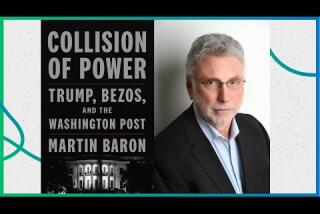Rachel Maddow plots America’s ‘Drift’ to easy war
SEATTLE -- This weekend, MSNBC’s Rachel Maddow and I sat down in a couple of armchairs and talked about how America drifts to war.
Maddow is on a frenetic cross-country tour to publicize “Drift,” her new book that shot to the top of the New York Times bestseller list as soon as it was released. She flew in for a few hours in Seattle on Saturday, and I interviewed her in front of a standing-room-only crowd at Town Hall. In liberal Seattle, Maddow is a rock star, and she got a rock star’s greeting when she walked onstage in her very casual clothes (including sneakers with Halloween-orange shoelaces).
She’s the one commentator on MSNBC, other than Chris Matthews, perhaps, that Republicans can tolerate. She is as opinionated as any of them, but she doesn’t rant. Her commentaries are backed by solid research, and her interviewing style is accommodating and respectful -- fun, even -- rather than sneering and confrontational. She’s no Sean Hannity, in other words.
Her book very much reflects the way she comports herself on TV. It is smart and deeply documented. It is entertaining and occasionally whimsical. (In any other book about national security issues, you would not find the word “whoopsie,” nor would the word “ally” be rhymed with “schmally” in one phrase.) And, far from being a left-wing screed, it presents a sharply argued commentary that many conservatives could buy into.
Maddow’s core thesis is that in the decades since the end of the war in Vietnam, there has been a steady and dramatic shift in the way the United States goes to war. There was a time when Congress stepped up to its constitutional responsibility to say when the country would send troops into battle. Once engaged, the entire country took part. Now, Maddow writes, the president can churn up a war anytime he wants, Congress rolls over, and only a tiny fraction of Americans do the fighting while the rest blithely carry on with their normal lives.
No one schemed to make this happen. It was brought about in incremental steps, each responding to a particular political quandary or international crisis. Maddow describes those steps in a way that makes her book a real page-turner, at least for a history-and-politics wonk like me.
Her retelling of the scandalous Iran-Contra saga is especially good -- almost like a breezy spy novel. She presents a cavalier cast of characters -- including Oliver North, John Poindexter and, of course, the star, Ronald Reagan -- and explains how they took a twisted path from a public commitment to never make deals with terrorists to the deal they secretly made with terrorists.
And there is a surprising climax to this chapter. The scandal did not end with the president being brought down. Instead, it ended with the political world buying into the “unitary executive” theory of then-Atty. Gen. Ed Meese -- the curious contention that the president, as commander in chief, can do whatever he wants in the realm of national security.
Iran-Contra was just one kink in a long, knotted string of developments that took us from where we were to where we are, and the culpable parties are Republicans and Democrats.
The best thing Maddow does is resist portraying the drift to unfettered war power as a conspiracy concocted by an evil cabal. These choices were made by intelligent men and women who seemed to truly believe they had the best interests of the country in mind. These very smart, patriotic people promoted really foolish policies because they were guided by poor information, blinded by ideology or driven by political expediency. With rare exceptions, they were not motivated by actual wickedness. (For pure wickedness, check out Maddow’s chapters covering the misdeeds and greed of private contractors in the Balkans and Iraq.)
Rachel Maddow is wise enough to recognize that, even at the highest levels of government, human folly explains far more than any conspiracy theory. It’s really all about “whoopsie” moments on a disturbingly grand scale.
More to Read
A cure for the common opinion
Get thought-provoking perspectives with our weekly newsletter.
You may occasionally receive promotional content from the Los Angeles Times.











